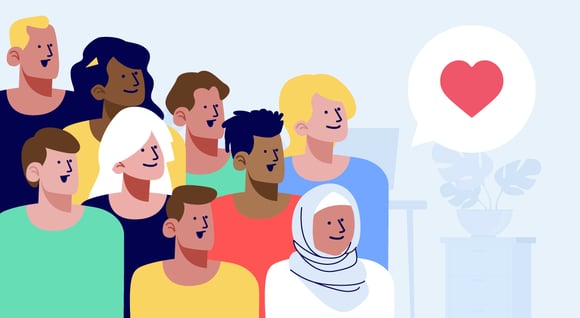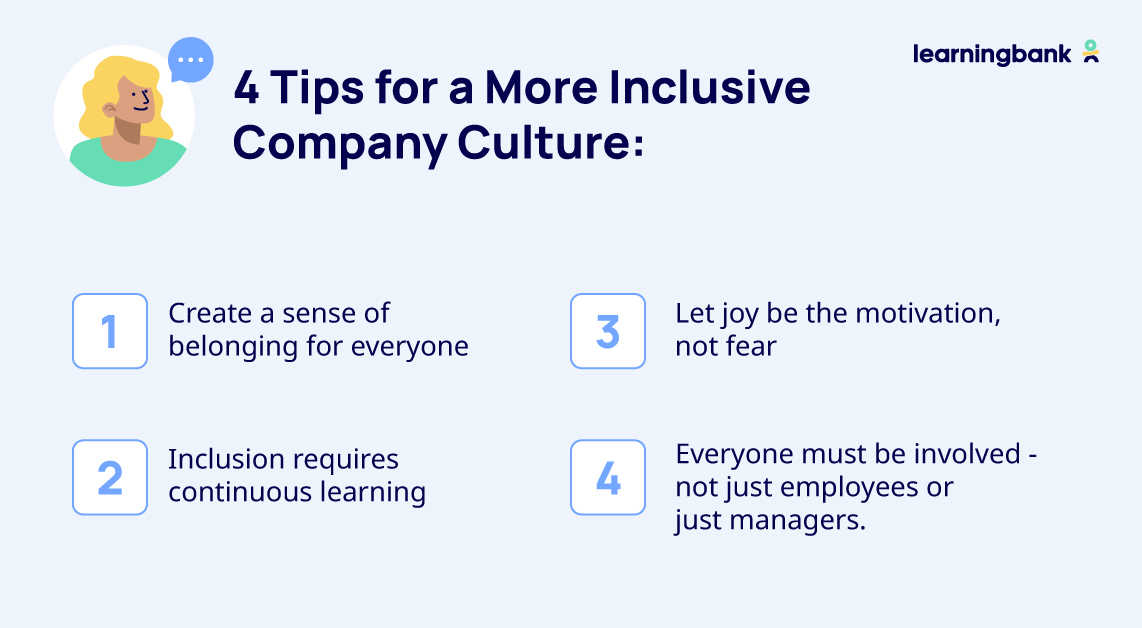Nelson Mandela once said, "Education is the most powerful weapon which you can use to change the world."
One step to changing the world is changing our workplace culture by educating ourselves and our employees. Through learning, we can gain new perspectives to help us challenge prejudices, overcome biases, and break down barriers.
Learning can become the catalyst for building bridges between people and creating a more inclusive and equal work culture and society.
Diversity, equity, and inclusion (DE&I) is a broad term that refers to the practice of creating a workplace where everyone feels welcome, valued, and respected, regardless of their background. But since you are here, you already know that.
Stats that Convince
However, if you need more reasons than "it's the right thing to do", to motivate management to invest in your organizational culture and DE&I initiatives more, here are a few more:
- Diversity, Equity, and Inclusion (DE&I) lead to innovation, high-performing teams, and positive growth for companies.
- Companies in the top quartile for gender diversity in management teams have a 25% higher likelihood of above-average profitability compared to those in the fourth quartile, according to McKinsey & Company.
- Inclusive organizations are twice as likely to achieve or exceed financial targets, 3 times more likely to be high performing, 6 times more likely to be innovative and agile, and 8 times more likely to achieve better business outcomes, as per Deloitte Insights and Juliet Bourke.
- A lack of inclusive culture will lead to job offer rejections, with 39% of respondents in the same McKinsey study mentioned above stating they have passed on offers due to this reason.
- Research published by PwC, shows that 54% of women and 45% of men consider a company's DE&I policies before accepting a job offer, emphasizing the importance of DE&I for attracting talent.
How to Start Your DE&I Work
Challenging Privileges & Prejudices
First, let us discuss privileges and prejudices. Do you have any?
Off course you do. We all do.
But it is not always easy to take a critical look at oneself and come to the understanding of our own self-view and how it's reflected in our actions and thoughts. It is also not surprising that so many people are not aware of their own privileges based on, for example, ethnicity, gender, sexual orientation, or one's nationality.
What is Privilege & Why Does it Matter?
Privilege is usually described as hard-to-attain advantages that a person has. Some may not recognize themselves as having those privileges, which makes it easy to dismiss them.
If we instead look at privilege as an absence of disadvantages, an absence of certain obstacles and challenges. And when you do not have it, it affects everything you do and how others perceive you in this world. Whereas if you have privilege, you often don't even notice it yourself.
Those who do not experience certain disadvantages often aren't even aware of it, or that they even exist. Therefore, we need to talk about them together so that we all become aware of them. This also applies to the prejudices we all have.
It is first when we become aware of it that we can open the door to a more positive culture. Being aware lets us see how it is reflected in our words, our actions, our cultures, and communities, and it will also help us understand others. From here we can take the next step and begin the process of change toward an inclusive culture that benefits us all.
How to Change Culture at Work
Creating change requires taking the subject seriously. A short DE&I training or a one-day workshop or one-week campaign on, for example, sexual harassment or LGBTQIA+- rights once a year is not enough to make an inclusive workplace culture. An organization's cultural change requires time and constant work, which in turn, is a learning process.
And yes, we will all fail at times. That's why we need to keep working, stop and reflect, learn from our mistakes, and improve. Changing habits does not happen overnight.
We must learn to see, appreciate and invite differences so that everyone feels confident contributing to innovation and solutions, acknowledge the differences and embrace them. This is easy to say but harder to do.
We cannot begin to dismantle the unfair privileges and prejudices that exist until we can see them. The work starts with us, but to create cultural change in our workplace, we often need a little nudge in the right direction to help us learn and grow together.
Using employee training and learning is a big part of making a big organizational change to give all employees a better experience as well as to drive long-term company success.
4 Tips for a More Inclusive Company Culture:
1. Create a sense of belonging for everyone
A sense of belonging to a team or company that makes you feel like you can be yourself leads to stronger engagement and creativity in the workplace.
The foundation for this is best laid even before your new employees' first day with an inviting preboarding. Continuing on with a good onboarding where the new employee gets to know the company culture, values, and visions is a good way to weave in inclusive core values that will permeate your business right from the start.
2. Inclusion requires continuous learning
Do not treat inclusion and diversity as a one-off event to be ticked off. It needs constant work. Think of it as any other soft skill. The more you practice, the better you get.
Give time and opportunity to build new habits. One way to get started and create reflection and awareness of prejudice and privilege is to use digital, gamified diversity and inclusion training for employees and managers. An engaging learning environment can spark a new culture of inclusion in your workplace, even if it is remote.
3. Let joy be the motivation, not fear
While fear can be a motivator, it often causes us to shut down and encourages more narrow-minded perspectives.
Instead, as a leader, use positive encouragement as a guide, celebrate the small wins, and create opportunities for open communication between different employees and teams to see challenges as an opportunity and drivers of positive change.
4. Everyone Plays a Part
Change must happen at all levels. From top management to your employees on the floor. Everyone must see their part in it. A culture is only as good as what we allow.
How can everyone at different levels contribute?
Employees: Participate in diversity and inclusion training and speak up if you witness microaggressions. By taking these steps, employees become active participants in building a more inclusive environment.
Managers: Advocate for inclusive practices, mentor employees from diverse backgrounds, and hold teams accountable for fostering a welcoming environment. Managers play a crucial role in creating inclusive teams where everyone feels valued.
Executives: Set the tone from the top by championing inclusion efforts, allocating resources for training and initiatives, and embedding diversity goals into company strategy. Executives provide the leadership and resources needed to make inclusion a core value of the organization.
Summing up
In conclusion, education and learning can help us challenge our prejudices, overcome biases, break down barriers, build bridges between people, and create a more inclusive and equal society.
By supporting our employees' professional development, we can make a difference in spreading kindness and change. However, it's important to recognize that there is no quick fix to achieving a more inclusive and better workplace.
Let's remember that learning is not just about acquiring knowledge; it is also about nurturing kindness. When we approach learning with an open mind and a genuine desire to understand others, we can cultivate empathy and compassion.
These qualities enable us to connect with our colleagues, appreciate their unique experiences, and foster an inclusive and respectful work environment.
By championing DE&I initiatives within our organizations, we can contribute to creating a more just and equitable world and shift the narrative.
Want more tips on how to create a more inclusive workplace and better well-being for your employees? Keep reading to find out how you can create more inclusive employee training.


